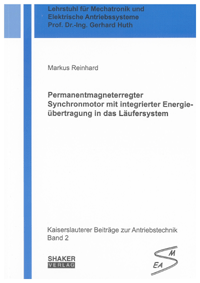
Catalogus : Recensies
Recensies

|
Markus Reinhard Permanentmagneterregter Synchronmotor mit integrierter Energieübertragung in das Läufersystem Volume 2 ISBN: 978-3-8322-8170-0 Prijs: 45,80 € / 91,60 SFR |
|---|---|
| A variety of applications requires electric power on a moving and especially rotating part. One example is the power supply of a measurement device on a rotating or moving part. Another example is the supply of energy to clump a tool on a direct driven spindle. Also the subsequent electric machines of multi axis industrial robots have to be powered. The thesis deals with the analysis, optimization, construction and measurement of a new electric machine with integrated contactless power transmission on the rotor system. Today´s technology uses contact or non-contact solutions. Contact solutions are slip rings and trailing cables. Non-contact solutions are ferrite transducers. These solutions have in common an additional component that has to be attached to the drive housing. Hence, additional construction space is necessary. In addition the complexity and the costs of the system will rise. Therefore it is reasonable to investigate solutions with integrated non-contact power delivery. With this contribution a concept is elaborated that features a motor with integrated contactless inductive power transmission. Problems like brush wear and broken trailing cables can be overcome. Both functions, drive and energy transmission, are completely independent. The hardware of both functions is separated, which means both functions feature their own hardware. There are two inverters and two windings sharing the same stator slots. Above this, the control of both functions is independent. The two functions may operate at the same time or alternating. Through the separated realization, the design process of the machine is simplified, the optimization of both functions can be done independently within specific limits. Also the operational reliability increases. The proposed motor is a permanent excited synchronous machine with one additional three-phase winding in the stator and one additional three-phase winding in the rotor for the energy transmission. The independence of both functions is gained by a appropriate choice of the winding parameters. | |
| Bron: ETDE - Energy Database des Leibniz-Instituts für Informationsinfrastruktur (FIZ Karlsruhe), production no.: DE10GC412 | |
| verder naar publicatie ... | |